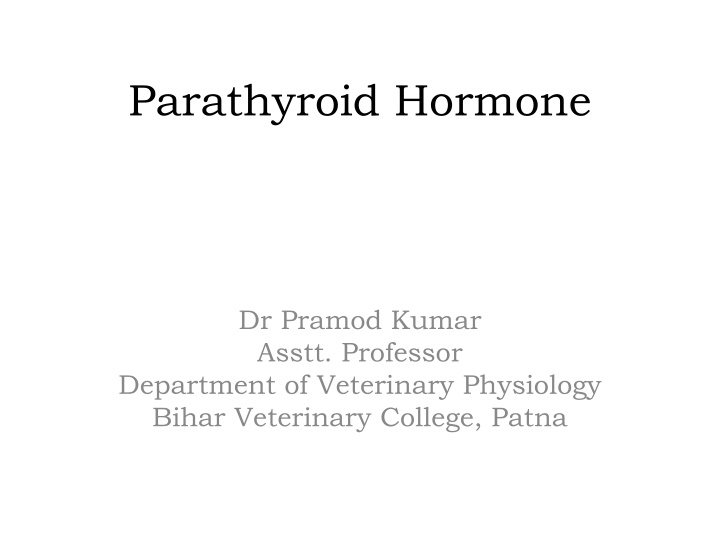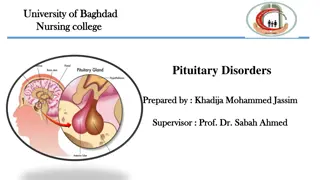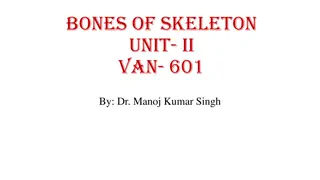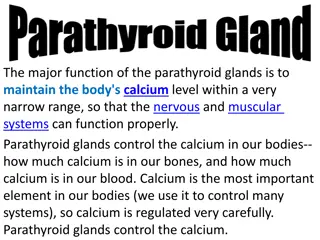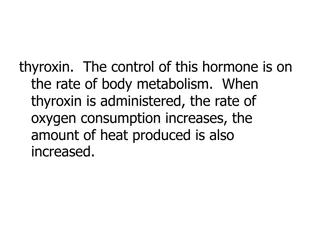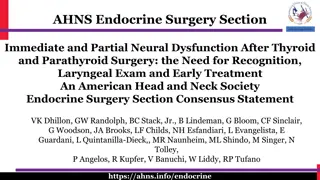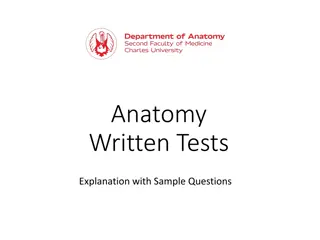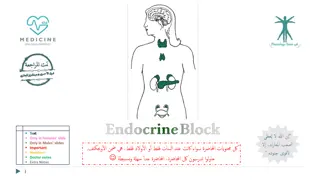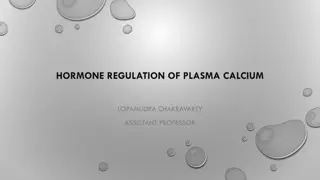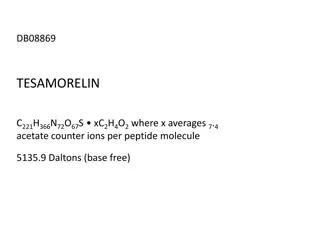Parathyroid Hormone: Functional Anatomy and Regulation
Parathyroid hormone, synthesized and secreted by the parathyroid glands, plays a crucial role in regulating calcium and phosphate levels in the body. This hormone acts on bone, kidneys, and intestines to maintain mineral homeostasis. The secretion of PTH is tightly regulated by factors like plasma calcium levels, serum magnesium concentration, plasma phosphate concentration, and vitamin D. Understanding the mechanism of action of PTH helps in comprehending its impact on bone metabolism and overall endocrine function.
Download Presentation

Please find below an Image/Link to download the presentation.
The content on the website is provided AS IS for your information and personal use only. It may not be sold, licensed, or shared on other websites without obtaining consent from the author.If you encounter any issues during the download, it is possible that the publisher has removed the file from their server.
You are allowed to download the files provided on this website for personal or commercial use, subject to the condition that they are used lawfully. All files are the property of their respective owners.
The content on the website is provided AS IS for your information and personal use only. It may not be sold, licensed, or shared on other websites without obtaining consent from the author.
E N D
Presentation Transcript
Parathyroid Hormone Dr Pramod Kumar Asstt. Professor Department of Veterinary Physiology Bihar Veterinary College, Patna
Functional Anatomy of Parathyroid Glands o Two pairs of small endocrine glands situated beyond the thyroid gland o size as of a split pea
Histological structure o Parenchyma of gland and arranged in cords. o Types of cells: o Chief numerous parathormone. o Oxyphil cells - larger than chief cells and appears at puberty and their function is still not clear. cells - and principal secrete cells, more PTH or
Structure, Synthesis and Secretion o Structure - single chain polypeptide containing 84 amino acids and having MW 9500. o Synthesis- precursor molecule called prepro-PTH, contains 115 amino acids. o Secretion - released from chief cells by exocytosis in response to decrease in plasma-ionized calcium concentration.
Regulation o Role of plasma-ionized calcium. o Role of serum Mg concentration. o Role of plasma phosphate concentration. o Role of vitamin 1,25(OH)2D3.
o Plasma level is about l30 pg/mL o Half-life in plasma is 5 8 min o Degradation peripheral tissues occurs rapidly in the o PTH is predominantly split in the liver.
Mechanism of action Actions on bone - stimulates calcium and phosphate reabsorption from the bones o Rapid phase of demineralization: osteocytic osteolysis In this process, the calcium is transferred from the bone canalicular fluid into the osteocytes and then into the ECF. Phosphate is not mobilized along with ca. o Slow phase of demineralization: stimulates the formation of new osteoclasts from the osteoprogenitor initiate process of bone resorption Ca and phosphate are released from bone and transferred to the ECF.
Actions on kidney: o Increase in calcium reabsorption from the ascending limb and the distal tubules which helps to prevent hypocalcaemia. o Inhibition of phosphate reabsorption in the proximal tubule, produces phosphaturia and hypophosphataemia. o Stimulation of reabsorption of Mg2+ by the renal tubules. o Stimulation of synthesis of 1,25- dihydroxy- cholecalcifrol.
Actions on intestines o Enhances Ca and phosphate absorption intestine by ing synthesis of 1,25- dihydroxy- cholecalciferol in the kidney from
Hyperparathyroidism Primary hyperparathyroidism: occurs due to excessive secretion autonomous parathyroid adenoma. by single Clinicobiochemical features: o Hypercalcaemia weakness, lethargy and constipation. may produce muscle o Ca stimulate release of gastrin to occur hyperchlorhydria and peptic ulceration. o Hypercalcaemia cardiac arrhythmias and ECG changes cause hypertension,
Secondary hyperparathyroidism: o Excessive secretion occur to persistent hypocalcaemia causes stimulation of parathyroid gland. continued o Aetiology: typically seen in slowly developing renal failure. o Clinicobiochemical pains, fractures and deformity may result. Alkaline osteocalcin levels are elevated. features: Bone phosphatase and
Hypercalcaemia can be divided into two groups: o Conditions associated hypercalcaemia and raised PTH levels o Conditions associated hypercalcaemia undetectable PTH levels are: Hypercalcaemia of malignancy Multiple myeloma Familial hypercalcaemia Hyperthyroidism with with or and low
Hypo-parathyroidism refers to a clinical condition characterized by low level of plasma calcium either due to deficient production of unresponsiveness. It can be classified into two main groups: True hypoparathyroidism - deficient production due to heritable or acquired causes. Post-operative hypoparathyroidism most common cause is due to damage to glands or their blood supply PTH or its -
Pseudohypoparathyroidism - congenital condition in which PTH production is normal but target tissues are resistant to its effects. Defect may lie in parathyroid receptors or there may be post-receptor defect. Clinical and biochemical features are similar to hypoparathyroidism but PTH levels are elevated
Tetany It refers to a clinical condition resulting from increased neuromuscular excitability. Causes of tetany include: Hypocalcaemia Extracellular Ca plays an important role in membrane integrity and excitability. Hypomagnesaemia - causes tetany because Mg ions are associated with neuromuscular irritability. Alkalosis reduces ionic Ca and can produce tetany.
